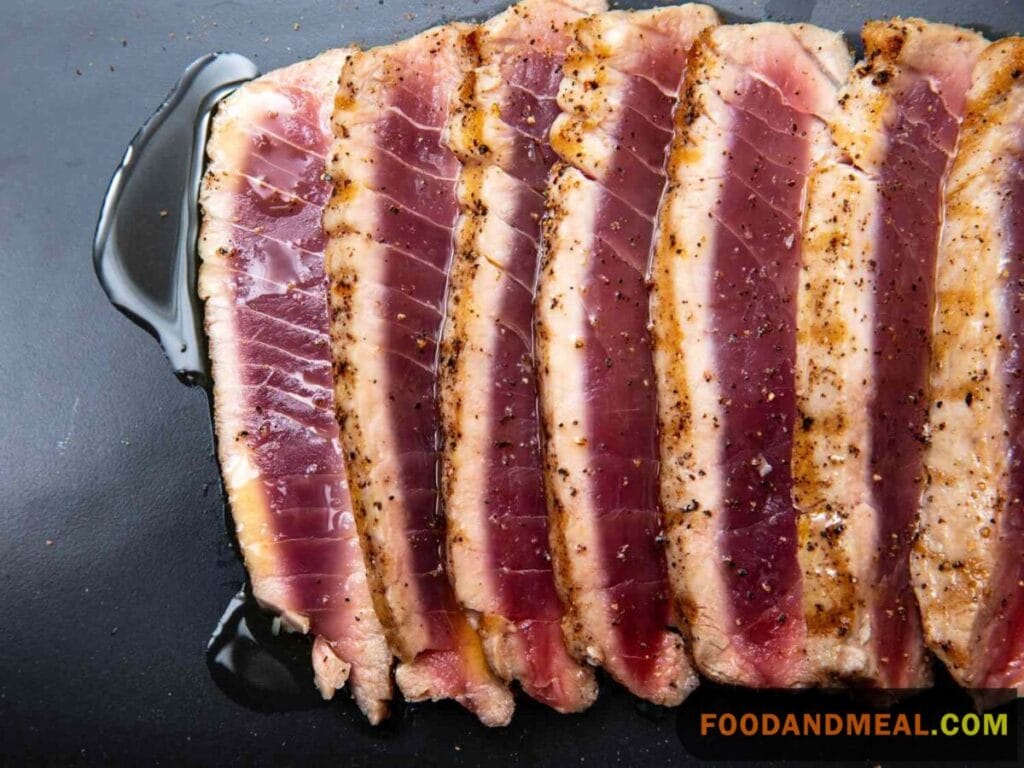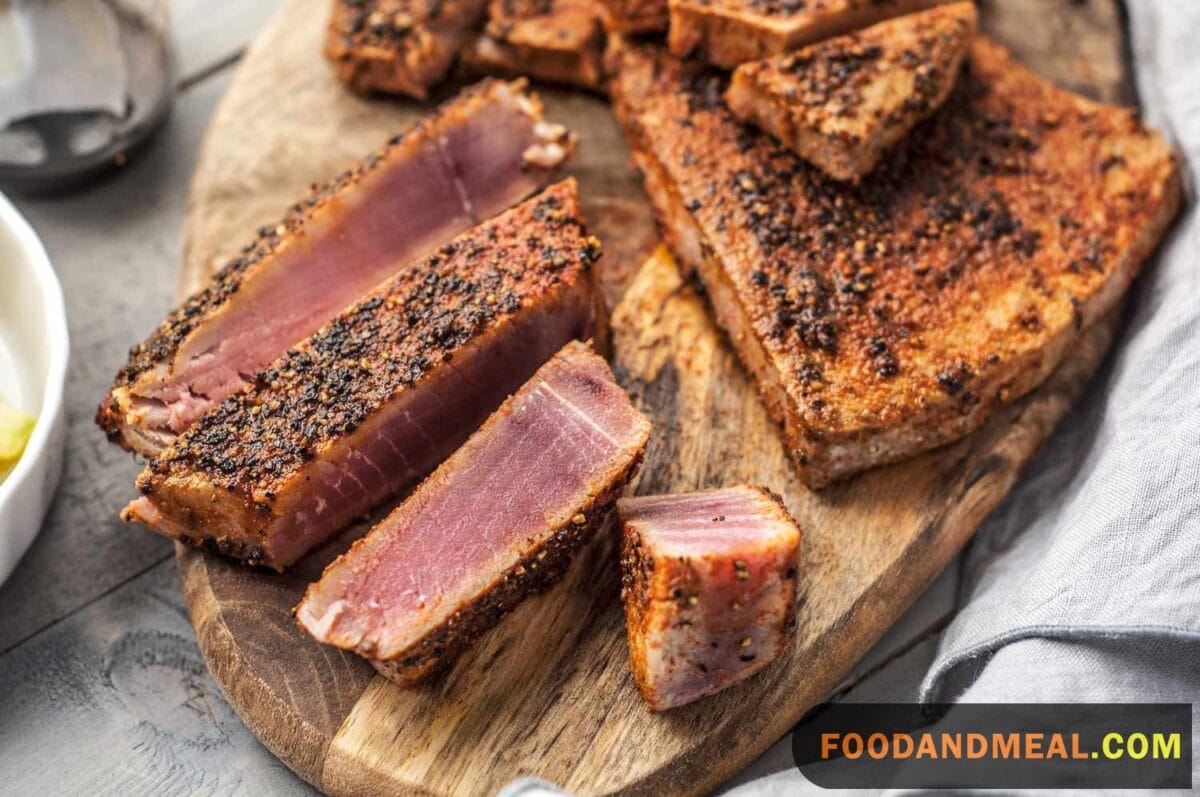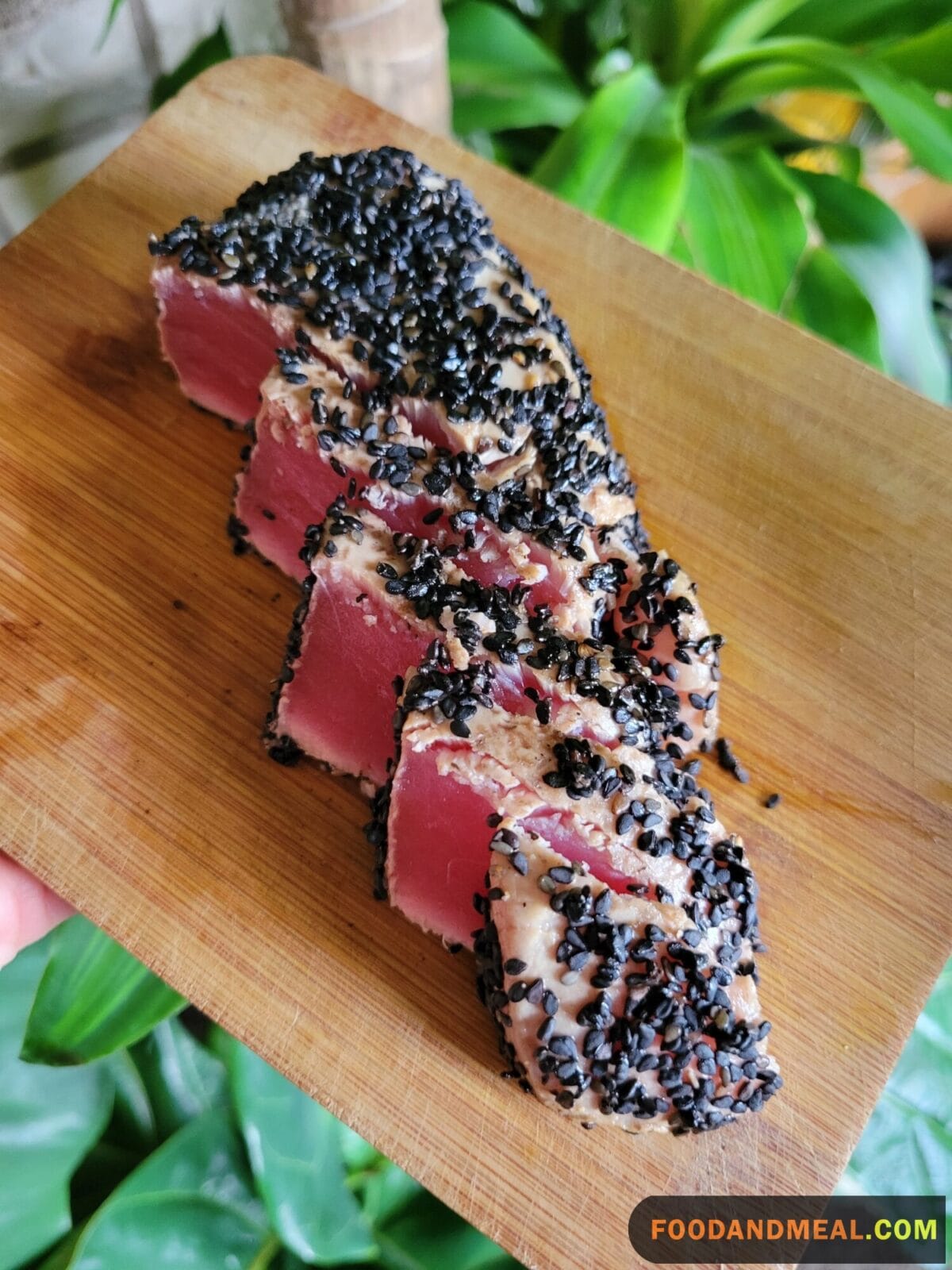The alluring aroma of a perfectly seared tuna steak sizzling on the grill is enough to make any seafood lover swoon. At Food and Meal, tuna holds a special place in our hearts and kitchens. From the velvety texture of the ruby-red flesh to the rich, meaty flavor, tuna is a protein we never tire of.
In my family, tuna steak night elicits feelings of comfort, celebration, and togetherness. Ever since I was a child, my father would fire up the backyard grill on momentous occasions and cook up the most mouthwatering tuna steaks basted in teriyaki and sesame. The anticipation of that first succulent bite still brings me right back to simpler times of laughter and joy around the dinner table.
Now, I want to share the secrets behind my favorite tuna steak recipe so that you too can create moments of culinary magic. Perfectly seared on the outside and tender within, this Asian-inspired preparation combines sweet, salty, savory flavors for a truly unforgettable meal.
Join me on a journey where we’ll learn how easy yet rewarding it is to make restaurant-quality tuna steak from the comfort of home. I’ll provide tips and tricks for choosing only the freshest cuts of tuna and mastering the art of grilling it to absolute perfection. Let’s dive in and discover just how a basic fillet of fish can be transformed into a mouthwatering masterpiece with the right marinade and a sizzling hot grill.
Tuna steak recipe


Tuna steak
Equipment
Ingredients
- 800 g tuna
- Black pepper coarse
- Sea salt coarse
- 2 cloves of garlic
- 1 lime
- Olive oil
Instructions
- Turn on the contact grill.
- Wash and drain the tuna.
- Cut the tuna into four steaks.
- Cook the steaks on the contact grill, frying for about 3 minutes.
- Squeeze the lime and mix the juice with oil, salt, pepper and garlic.
- Cut the spring onions into rings, wash and drain.
- Salt and pepper the fish and serve with the marinade and spring onions.
Video
Nutrition
© Food And Meal
This website provides approximate nutrition information for convenience and as a courtesy only. Nutrition data is gathered primarily from the Spoonacular Database, whenever available, or otherwise other online calculators.
How to making tuna steak using oven

The rich, meaty flavor of tuna steak is a delight I dream of recreating within the warmth of my own kitchen. As I preheat the oven and lay the fresh tuna steaks onto a baking sheet, anticipation bubbles up inside me. I sprinkle coarse sea salt and cracked black pepper over the tuna, massaging the seasoning gently into the flesh. The cutting board is strewn with remnants of lemon zest, garlic, and rosemary—the foundations of a pungent, herbaceous marinade which will soon coat and infuse the fish.
Sliding the tuna into the hot oven, I’m enveloped by the aromatic mingling of fragrant citrus, peppery spice and good, honest fish. My excitement builds as I envision that first succulent forkful—the crispy seared exterior giving way to a tender, velvety center. Patience is essential now; I must allow the oven’s steady heat to work its magic, sealing the tuna’s juices inside while bronzing the surface a perfect golden brown.
Soon, the kitchen fills with the symphony of sizzling tuna hitting hot metal. I remove the baking sheet with bated breath, thrilled to see the gorgeous caramelized crust that has formed. As the tuna rests, steam rising gently, I sprinkle on some fresh parsley and slice into the steak with care. The knife glides smoothly through delicate flakes. Finally, I plate up the tuna, still faintly pink in the middle, its texture luscious yet nicely resilient. Topped with a squeeze of lemon and served alongside fresh greens, this oven-baked tuna is a dish to savor. And as I take my first blissful bite, eyes closed, I am already planning the next culinary adventure to undertake within my tiny kitchen.
Tips for making tuna steak

Cooking Tips
Cooking tuna steak is an art that fills me with anticipation and delight. As I unwrap the fresh, ruby-red fillets, their rich, briny aroma seems to whisper tales of the clear blue sea. My excitement builds as I prepare a marinade—a little soy sauce, brown sugar, minced garlic, sesame oil—knowing soon the tuna will absorb these lovely flavors.
Patience and care are so important when handling this delicate fish. I pat the tuna dry to allow for optimal searing, then massage the marinade gently into the flesh. The cutting board becomes stained with remnants of garlic and flecks of ginger, remnants of flavors soon to permeate the rare tuna.
The sizzle of tuna hitting a hot pan elicits a thrill. I resist the urge to move the fillets too soon, allowing a crusty sear to form, sealing in juices. While the fish cooks, I dream up accompaniments in my mind’s eye: wilted greens, citrusy rice, a cooling sauce to balance the richness.
Soon the kitchen fills with the symphony of pans and promises. I peek at the tuna, now lightly bronzed on the outside yet still glistening within. When I slice into the first fillet, the knife glides smoothly through tender meat the color of the summer sunset. As steam rises gently, I know this tuna is cooked to buttery perfection. Plating up, I feel only joy and satisfaction, having unlocked the secrets of this magnificent fish. I close my eyes and breathe deeply, embracing the meal’s aroma before savoring my very first blissful bite.
Serving Suggestions
- Tuna Steak with Green Bean Salad – Seared tuna steak served with a light salad of green beans, tomatoes, olives, and a lemon vinaigrette.
- Orange Flavored Baked Tuna Steak – Tuna steak baked with orange juice, soy sauce, brown sugar, and garlic.
- Tuna Steak with Peach and Avocado Salad – Grilled tuna steak served over mixed greens with peaches, avocado, red onion, and a balsamic dressing.
- Marmite Tuna Steak – Tuna steak coated in a savory Marmite and breadcrumb crust then pan-fried.
- Grilled Tuna Steak – Simple preparation of tuna steak seasoned with salt, pepper, and olive oil then grilled to desired doneness.
- Zesty Baked Tuna – Tuna steaks coated in a mixture of zesty Italian dressing, breadcrumbs, and Parmesan cheese then baked.
- Tuna Steak with Lemon Pepper Sauce – Pan seared tuna steak served with a lemon pepper cream sauce.
- Teriyaki Tuna Skewers – Tuna steak chunks threaded onto skewers, glazed with teriyaki sauce, and grilled.
- Tuna and White Bean Protein Salad – Chunks of grilled tuna steak mixed with white beans, spinach, red onion, and a lemon vinaigrette.
Top 5 FAQs about tuna steak
- How do I know when my tuna steak is cooked properly?
Check for the level of doneness by the color and texture. For rare tuna, the center should be bright red with a soft, velvety texture. Medium-rare tuna will be pink in the middle while the outer portion is opaque. Use your fingers to test thickness for firmness.
- What is the best way to cook a tuna steak?
Grilling, pan searing, or broiling tuna steaks are all excellent cooking methods. Make sure to pat the steaks dry before cooking and use high heat to get a nice sear while keeping the interior moist. Basting with a teriyaki glaze adds great flavor too.
- What sides go well with seared tuna steak?
Tuna steak pairs nicely with rice, vegetables, greens, or pasta. Try tuna with pineapples or mango salsa for a delicious sweet and savory combo. Stir-fried veggies like bok choy or roasted potatoes also complement seared tuna wonderfully.
- How long does tuna steak last in the fridge?
Fresh tuna steaks will keep for 2-3 days in the fridge. For longer storage, wrap the tuna tightly and freeze for 2-3 months. Thaw frozen tuna in the fridge before cooking. Tuna steaks should be consumed immediately after cooking for best quality.
- How can I tell if my tuna steak is fresh?
Check that fresh tuna steaks have a clean scent, firm flesh, and bright red color. Dull, brownish hues mean the tuna is old. Fresh tuna also has a translucent quality while the skin should be shiny, tight, and metallic looking. Shop tuna steaks the same day for cooking.
Conclusion

Tuna steak is a versatile and nutritious seafood option that makes for a satisfying meal. When properly sourced and prepared, tuna steak can provide high-quality protein, omega-3 fatty acids, vitamins, and minerals. Choosing tuna labeled as “pole and line caught” supports more sustainable fishing practices.
When cooking tuna steak at home, it is best cooked quickly over high heat, such as grilling or pan searing, to create a caramelized exterior while keeping the interior rare to medium-rare. This preserves the delicate flavor and texture of the tuna. Take care not to overcook tuna, as it can become dry.
Tuna steak pairs well with various global flavors. An Asian-inspired marinade with sesame oil, soy sauce, brown sugar, and spices beautifully complements tuna. Compound butters and chimichurri also make flavorful finishes. Serve alongside fresh vegetables or grains to complete the meal.
With responsible sourcing, proper cooking techniques, and creative seasonings, tuna steak makes for a luscious center-of-the-plate option full of nutrition and bold, savory flavor. It satisfies seafood cravings while bringing people together to enjoy a tasty, memorable meal.
- Cooking Like A Pro
- Author Name : Jaime Inez
- Address: Times Street, West Triangle, 1103, Quezon City, Metro Manila, Philippines
- Phone: 96-2-4108596
- Email: Contact@cookinglikeapro.net

